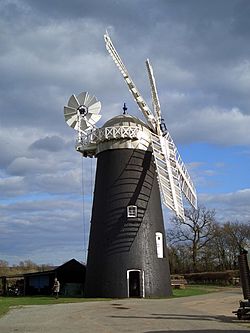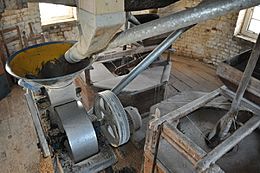Pakenham Windmill facts for kids
Pakenham Mill is a special old windmill located in Pakenham, Suffolk, England. It's a "Grade II* listed" building, which means it's very important historically and architecturally. This amazing tower mill has been carefully fixed up and is still working today! It's a great example of how windmills used to help people grind grain into flour.
Quick facts for kids Pakenham Mill |
|
|---|---|

The restored mill
|
|
| Origin | |
| Mill location | TL 931 694 |
| Coordinates | 52°17′19″N 0°49′56″E / 52.28861°N 0.83222°E |
| Operator(s) | Friends of Pakenham Windmill |
| Year built | 1831 |
| Information | |
| Purpose | Corn mill |
| Type | Tower mill |
| Storeys | Five storeys |
| No. of sails | Four Sails |
| Type of sails | Patent sails |
| Winding | Fantail |
| Fantail blades | Eight Blades |
| Auxiliary power | Steam engine |
| No. of pairs of millstones | Three pairs |
Contents
The Story of Pakenham Mill
Building and Early Years
Pakenham Mill was built a long time ago, in 1831. In 1846, a miller named Clement Goodrich worked there. He even took on a young apprentice to learn the trade. Later, in 1885, the Bryant family took over the mill. They used a steam engine to help power the mill when there wasn't enough wind.
Close Calls and First Repairs
In 1947, the mill had a scary moment! It almost got "tail-winded," which means the wind nearly hit the back of the mill's cap, causing damage. Luckily, the miller was quick and turned the cap just in time.
After this, the mill was repaired in 1950. A new strong beam, called a weatherbeam, was put in place. Parts from other old windmills were also used to help fix Pakenham Mill. A special walkway, called a gallery, was built around the top of the mill. New sails were also added so the mill could keep working.
More Restorations and Lightning Strike
More big repairs happened in 1961. Local councils and the government helped pay for the work. The Bryant family promised to keep the mill running. The top of the mill, called the cap, was rebuilt and covered in aluminum to make it easier to look after. New sails were made, and the fantail, which helps the mill face the wind, was also fixed.
In June 1971, lightning struck the mill! It split one of the main beams and damaged a sail. Luckily, a metal chain inside the mill helped the lightning go safely into the ground, stopping a fire. After this, a lightning conductor was added to protect the mill from future strikes.
Recent Repairs
The most recent major restoration of Pakenham windmill finished in May 2000. This big project cost £60,000. Most of the money came from the Heritage Lottery Fund, which helps preserve important historical sites.
How Pakenham Mill Works
Pakenham Mill is a "tower mill" with five floors. It has a round, domed cap at the top with a walkway around it. A special part called a fantail helps turn the cap so the sails always face the wind.
Inside, the mill has three pairs of millstones, but only two pairs are still used today. These millstones grind grain into flour. The parts that control the millstones are driven by chains, which is a bit unusual compared to other mills that use belts.
Millers of Pakenham Mill
- Clement Goodrich (around 1846)
- Bryant family (from 1885 onwards)
- John Bryant (until 1947)
Visiting Pakenham Mill
You can visit Pakenham Mill! It's usually open every day during working hours for individuals. If you have a group, you can arrange a special visit. The mill is also open on both Saturday and Sunday of National Mills Weekend, from 2:00 PM to 5:30 PM. It's a great chance to see a working windmill up close!
Pakenham Mill in Media
Pakenham windmill has appeared in several films and TV shows:
- It was in a short film called And now they rest, released in 1938.
- The BBC used footage of Pakenham windmill in the 1950s as short breaks between TV programmes.
- It appeared in an episode of the TV series Survivors in 1977. The episode was called The Peacemaker.


